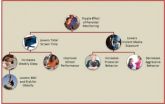(Press-News.org) Bottom Line: Parental monitoring of the time children spend watching television, playing video games and being online can be associated with more sleep, improved school performance and better behavior by the children.
Author: Douglas A. Gentile, Ph.D., of Iowa State University, Ames, and colleagues.
Background: Previous research suggests high levels of screen time are associated with less sleep, attention problems and lower academic progress.
How the Study Was Conducted: The study included self-reported data from 1,323 school children (in the third through fifth grades) from two communities in Iowa and Minnesota, along with data about the students provided by primary caregivers and teachers. The data were collected as part of an obesity prevention program.
Results: Study results suggest that increased monitoring by parents reduced children's total screen time (TST) which results in children getting more sleep, doing better in school and having less aggressive behavior. The results suggest more sleep is associated with a lower body mass index (BMI). More parental monitoring also resulted in less exposure to violence on television and in video games, which was associated with increased positive behavior and decreased aggressive behavior.
Discussion: "Pediatricians, family practitioners, nurses and other health care professionals who encourage parents to be more involved in their children's media may be much more effective at improving a wide range of healthy behaviors than they realize."
INFORMATION:
(JAMA Pediatr. Published online March 31, 2014. doi:10.1001/jamapediatrics.2014.146. Available pre-embargo to the media at http://media.jamanetwork.com.)
Editor's Note: The study was sponsored by Medica Foundation, the Healthy and Active America Foundation, and Fairview Health Services in Lakeville, Minn. In Cedar Rapids, Iowa, the study was sponsored by Cargill Inc., and the Healthy and Active America Foundation. Switch is a registered trademark of Iowa State University. Please see article for additional information, including other authors, author contributions and affiliations, etc.
Media Advisory: To contact author Douglas A. Gentile, Ph.D., call Angie Hunt at 515-294-8986 or email amhunt@iastate.edu
Study finds parental monitoring of children's media use is beneficial
2014-03-31
ELSE PRESS RELEASES FROM THIS DATE:
HIV treatment while incarcerated helped prisoners achieve viral suppression
2014-03-31
Bottom Line: Treating inmates for the human immunodeficiency virus (HIV) while they were incarcerated in Connecticut helped a majority of them achieve viral suppression by the time they were released.
Author: Jaimie P. Meyer, M.D., of the Yale University School of Medicine, New Haven, Conn., and colleagues.
Background: Of the 1.2 million people living with HIV in the United States, about one-sixth of them will be incarcerated annually, and HIV prevalence is three-fold greater in prisons compared with community settings.
How the Study Was Conducted: The authors ...
Using more wood for construction can slash global reliance on fossil fuels
2014-03-31
A Yale University-led study has found that using more wood and less steel and concrete in building and bridge construction would substantially reduce global carbon dioxide emissions and fossil fuel consumption.
Despite an established forest conservation theory holding that tree harvesting should be strictly minimized to prevent the loss of biodiversity and to maintain carbon storage capacity, the new study shows that sustainable management of wood resources can achieve both goals while also reducing fossil fuel burning.
The results were published in the Journal of ...
Fast food giants' ads for healthier kids meals don't send the right message
2014-03-31
(Lebanon, NH, 3/31/14) — Fast food giants attempts at depicting healthier kids' meals frequently goes unnoticed by children ages 3 to 7 years old according to a new study by Dartmouth-Hitchcock Norris Cotton Cancer Center. In research published on March 31, 2014 in JAMA Pediatrics, Dartmouth researchers found that one-half to one-third of children did not identify milk when shown McDonald's and Burger King children's advertising images depicting that product. Sliced apples in Burger King's ads were identified as apples by only 10 percent of young viewers; instead most ...
EARTH Magazine: The trouble with turtles
2014-03-31
Alexandria, Va. – Turtles are the last major living vertebrate group to be placed firmly on the tree of life, and the arguments are getting messy. Three fields in particular — paleontology, developmental biology and microbiology/genomics — disagree about how, and from what, turtles may have evolved. In the latest EARTH Magazine feature story, contributing writer Naomi Lubick investigates how these creatures confound scientists on many levels — from their morphology in the paleontological record and in modern day turtles, to the analysis of their genome. Where do they belong ...
Limiting screen time yields mulitple benefits, ISU study finds
2014-03-31
AMES, Iowa – Parents may not always see it, but efforts to limit their children's screen time can make a difference. A new study, published in JAMA Pediatrics, found children get more sleep, do better in school, behave better and see other health benefits when parents limit content and the amount of time their children spend on the computer or in front of the TV.
Douglas Gentile, lead author and an associate professor of psychology at Iowa State, says the effect is not immediate and that makes it difficult for parents to recognize. As a result, parents may think it ...
Early cardiac risks linked to worse cognitive function in middle age
2014-03-31
Young adults with such cardiac risk factors as high blood pressure and elevated glucose levels have significantly worse cognitive function in middle age, according to a new study by dementia researchers at UC San Francisco.
The findings bolster the view that diseases like Alzheimer's develop over an individual's lifespan and may be set in motion early in life. And they offer hope that young adults may be able to lower their risk of developing dementia through diet and exercise, or even by taking medications.
"These cardiovascular risk factors are all quite modifiable," ...
Computer maps 21 distinct emotional expressions -- even 'happily disgusted'
2014-03-31
COLUMBUS, Ohio—Researchers at The Ohio State University have found a way for computers to recognize 21 distinct facial expressions—even expressions for complex or seemingly contradictory emotions such as "happily disgusted" or "sadly angry."
In the current issue of the Proceedings of the National Academy of Sciences, they report that they were able to more than triple the number of documented facial expressions that researchers can now use for cognitive analysis.
"We've gone beyond facial expressions for simple emotions like 'happy' or 'sad.' We found a strong consistency ...
Using your loaf to fight brain disease
2014-03-31
A humble ingredient of bread – baker's yeast – has provided scientists with remarkable new insights into understanding basic processes likely involved in diseases such as Parkinson's and cancer.
In a new study published today (Monday March 31) in the prestigious journal PNAS (Proceedings of the National Academy of Science), the team from Germany, Leicester, and Portugal detail a new advance – describing for the first time a key feature in cellular development linked to the onset of these devastating diseases.
The research team is from the University Medical Center Goettingen, ...
Can antibiotics cause autoimmunity?
2014-03-31
(PHILADELPHIA) -- The code for every gene includes a message at the end of it that signals the translation machinery to stop. Some diseases, such as cystic fibrosis and Duchenne muscular dystrophy, can result from mutations that insert this stop signal into the middle of an essential gene, causing the resulting protein to be truncated. Some antibiotics cause the cell's translation machinery to ignore the stop codons and are therefore being explored as a potential therapy for these diseases. But new research reported online in Proceedings of the National Academy of Sciences ...
Self-healing engineered muscle grown in the laboratory
2014-03-31
VIDEO:
After veins grow into the implanted engineered muscle fibers, blood cells can be seen traveling through them, sustaining and nourishing the new tissue.
Click here for more information.
DURHAM, N.C. -- Biomedical engineers have grown living skeletal muscle that looks a lot like the real thing. It contracts powerfully and rapidly, integrates into mice quickly, and for the first time, demonstrates the ability to heal itself both inside the laboratory and inside an animal.
The ...



